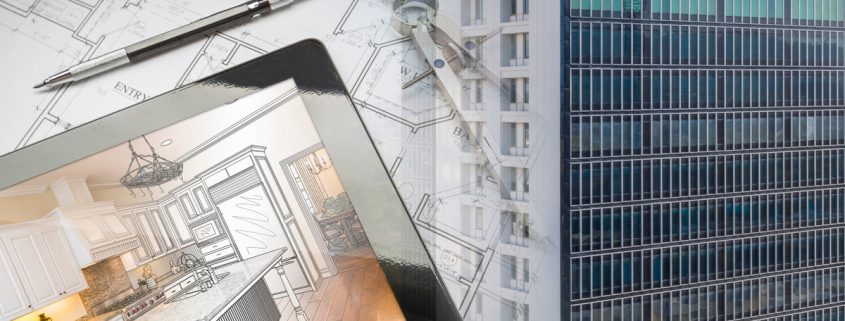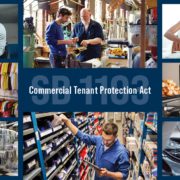Converting Office to Residential: Is It Possible?
As the office market continues to struggle locally and nationally, and multifamily vacancy rates in Southern California hover around 4%, converting underperforming office assets to residential would appear to be a logical solution to two problems. While this sounds great in theory, the reality of converting office product to apartments is far more challenging.
The Office Market
According to Voit Q3 market research, vacancy rates in Orange and San Diego counties are rising, asking rates are declining, and net absorption is in negative territory. The overall vacancy rate for Orange County increased to 17.47% in Q3, with Class A vacancy rising to 22.84% and availability (which includes sublease space and available direct space that is still occupied) increasing to 28.36%. In San Diego County, direct/sublease space (unoccupied) finished Q3 at 12.06%, and availability was 17.99% of the county’s inventory at the end of Q3. Although asking rents have remained steady and demand for high-quality space for users seeking requirements under 20,000 square feet remains steady, the near-term outlook for office in SoCal is less than encouraging.
Rental Housing
On the flip side, rental housing in Orange County and San Diego County is in short supply. A recent report by Rent Café named the MSAs as two of the most competitive rental markets in the nation. Out of 139 metros surveyed, San Diego ranked 18th in apartment occupancy at 96%, and Orange County was right behind at 19th, with a 95.7% occupancy rate. Seventeen renters were competing for the same apartment in San Diego at the time of the survey, and 13 faced similar frustrations in Orange County. The shortage of rental apartments stems from a limited supply of land for new development, elevated construction costs, and more recently, the cost of financing. Of the units rented, only about 0.2% of the available stock in both counties was newly built.
Why Not Convert Office into Residential?
From a national standpoint, a recent Deloitte Insights article reports that there is nearly one billion square feet of available office space in search of tenants in the United States. With a housing shortage of nearly three million units, unused downtown office space — particularly older B and C properties facing obsolescence — would seem to be a likely candidate for conversion to housing, but to date, that hasn’t been the case. From 2016 to 2021, there were an average of 31 office-to-housing conversions per year, totaling 188 projects, and there were only 217 conversion projects in the immediate pipeline for completion as of July 2023. After a spike in 2021, which saw 20,122 apartment units created from office conversions, developers created just 3,575 units in the U.S. last year, according to an analysis by RentCafe — a figure that is less than 1% of all apartments built that year through new construction.
In Southern California, there have been a number of office conversions in recent years. Since 2000, approximately 12,000 new housing units have been created in Downtown Los Angeles, the city’s oldest office market, through the adaptive reuse of mostly old office buildings, according to a recent Los Angeles Times article. Jamison Services, a Koreatown-based developer in Los Angeles that specializes in office-to-residential conversions, has converted seven office buildings in Los Angeles into 1,200 units since 2013 and is planning to convert a 17-story office building at 6380 Wilshire Boulevard into 210 apartment units. The 10-story former Social Security Administration building in Santa Ana in Orange County (now called 888 on Main) was converted into 148 apartments in 2022. Reven Capital is now planning to convert the 21-story hi-rise at 101 Ash St. into 400 apartments for low-income residents.
But even with that activity, it’s essentially been a drop in the bucket in terms of expanding housing stock. For example, Los Angeles ranked 5th among U.S. cities for the number of apartment units created from office conversions in 2020 and 2021, but that number was only 1,073, according to a Rent Café report.
With so much office product underperforming and unlikely to bounce back, doesn’t simply converting the office buildings into apartments make sense?
Conversion Feasibility
The problem is that most office building designs, particularly newer buildings, do not lend themselves to conversion. Architectural firm Gensler conducted a multiple-year study that assessed over 1,000 buildings in North America and determined that only 25% of the 1,000 buildings scored were suitable candidates for conversion. And of those that can be converted, a large percentage of them don’t necessarily pencil. The firm developed a data-driven, algorithmic tool for determining the compatibility of a building for conversion, using a scoring system that consists of five weighted criteria: Site Context, 10% (walkability, transit, daylight, and views); Building Form, 30% (shape of the building, how easy it is to plan units); Floor Plates, 30% (window to core distance, floorplate size, floor to floor height, and # of elevators); Building Envelope, 20% (sides with window, window to wall ratio, and ease of window replacement) and Servicing, 20% (loading, parking, structure, and MEP). The tool allows building owners to quickly assess if their building is a candidate for conversion.
Despite the somewhat low percentage of office buildings that can be converted into apartments, that still leaves a large number that can. The Gensler article concludes, “We have an unprecedented opportunity to create incredible new residential stock quickly, sustainably, and at a 30% lower cost than new construction.”
Government Programs Can Help
In October, the Biden administration announced plans to make converting office buildings into residential units easier for housing developers by offering billions of dollars in loans at below-market interest rates and identifying and marketing surplus federal properties representing the best commercial-to-residential opportunities. The administration also made the first edition of a guidebook available to developers. The Commercial to Residential Federal Resources Guidebook has information on over 20 federal programs across six federal agencies that can be used to support conversions.
In addition, the State of California lawmakers approved $400 million in incentives for commercial-to-residential conversions, including $105 million in grants to fund the conversion of commercial space into affordable and market-rate housing. In March of 2023, Co-Star reported that 55 developers and investors had filed applications to access roughly $105 million in grants to fund conversions.
Looking Ahead
Will these plans help to save the Downtowns across America and increase housing? That remains to be seen. The Deloitte article states, “A combination of some of the benefits provided by local governments can make the math work for conversions at scale. In particular, government incentive programs can help make conversions more feasible by easing restrictions around zoning and density, providing direct financial subsidies and tax abatements, and waiving off or redistributing infrastructure upgrade costs to a longer time horizon.”
The article then concludes with this: “We anticipate that, by 2027, shifts in rents, valuations, acquisition costs, and conversion costs, in addition to added government-backed incentives, could allow developers to achieve a net profit on conversions of underutilized office space in favor of residential space.









